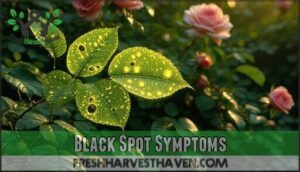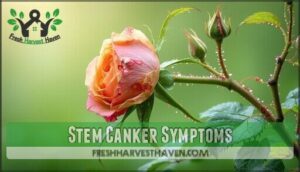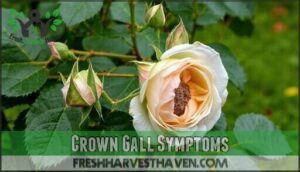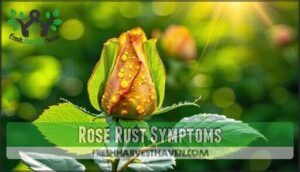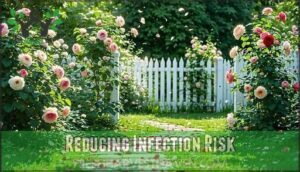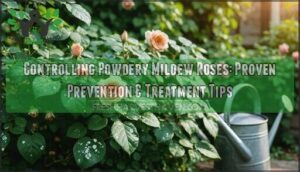This site is supported by our readers. We may earn a commission, at no cost to you, if you purchase through links.
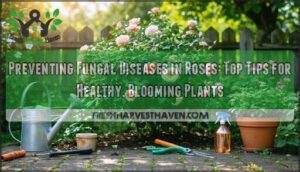
Keeping things tidy goes a long way—wipe down your tools between cuts and clear away any leaves that have dropped, since they can hide fungal spores.
For a little extra peace of mind, try using copper-based fungicides before you spot any problems; they work best as a preventative step.
Full sun locations naturally discourage most fungal problems, since pathogens thrive in humid, shaded conditions. The secret lies in creating an environment where your roses flourish but fungi struggle to gain a foothold.
Table Of Contents
- Key Takeaways
- Common Rose Diseases
- Disease Prevention Strategies
- Fungicide Options
- Rose Care Best Practices
- Preventing Fungal Diseases
- Frequently Asked Questions (FAQs)
- How to prevent fungus on roses?
- What is a preventative fungicide for roses?
- How to keep roses from getting disease?
- What is a natural fungicide for rose bushes?
- How to make rose disease resistant?
- When should I apply dormant spray?
- How often can I reapply fungicides?
- Are organic treatments effective against fungi?
- Can companion planting reduce fungal diseases?
- Should I remove surrounding mulch when infected?
- Conclusion
Key Takeaways
- Space roses out and prune regularly to boost airflow, which keeps fungal diseases at bay. – Always water at the base to avoid wetting leaves and spreading spores. – Choose disease-resistant rose varieties and rotate fungicides for best long-term protection. – Remove fallen leaves and sanitize pruning tools after every cut to stop fungi from spreading.
Common Rose Diseases
Your roses put on a big show, but they’re also magnets for some pretty common fungal diseases like black spot, rust, and powdery mildew.
Don’t worry—if you spot an odd blotch or a dusty coating, you’re not alone, and there’s clear science to help you keep your plants healthy.
Black Spot Symptoms
When you spot tiny, black irregular marks with yellow halos on lower leaves, you’ve just seen classic Black Spot—one of the top Rose diseases to watch for.
This Rose fungal disease symptom, called Leaf Spotting, quickly climbs the stem. As Lesion Appearance worsens, expect defoliation impact—leaves dropping off like dominoes.
This disease moves quickly, so spotting it early gives you the best shot at keeping your roses healthy.
Powdery Mildew Symptoms
While black spot creates dark blotches, powdery mildew appears as a distinctive white coating that blankets your roses. This rose fungal disease symptom looks like someone dusted flour across leaves and buds. Early detection helps prevent stunted growth and leaf curl that follows mildew identification.
Watch for these key rose disease symptoms:
- White coating spreading across foliage and stems
- Leaf curl with twisted, distorted growth patterns
- Stunted growth preventing normal flower development
Powdery mildew thrives in humid conditions, making fungal diseases of roses particularly troublesome during certain seasons.
Stem Canker Symptoms
When fungal diseases attack your rose canes, you’ll notice distinctive warning signs that signal trouble ahead. Canker identification starts with spotting lesion appearance – small yellow or brown spots that quickly develop into sunken, dark wounds with colored margins.
Stem discoloration spreads from entry points where pruning cuts or winter damage occurred. These cankers create girdling effects that choke off nutrients, leading to plant weakness and eventual cane death.
Rose disease symptoms progress rapidly once stem canker takes hold. These fungal diseases exploit wounds and stressed tissue, so catching them early prevents devastating rose diseases from spreading throughout your garden.
Crown Gall Symptoms
While cankers damage stems, crown gall creates bacterial infection nightmares that’ll devastate your roses. This bacterial disease produces unmistakable tumor development at your plant’s base, causing severe growth inhibition and plant weakness.
Gall identification helps you spot these rose diseases early:
- Light green or white soft swellings appear at the crown within 14 days
- Tumors harden into dark brown, woody masses over time
- Secondary galls develop near original infection sites annually
- Vascular damage restricts water and nutrient movement throughout the plant
- Stunted growth and reduced bloom counts signal established bacterial infection
Rose fungal disease symptoms differ from crown gall’s distinctive growths. Identifying rose diseases quickly prevents this bacterial invader from spreading through your garden via contaminated tools and wounds. This is particularly important since the disease is caused by Agrobacterium tumefaciens.
Rose Rust Symptoms
While crown gall creates swollen tumors at ground level, rose rust shows up differently on your plants. You’ll notice yellow spots appearing on upper leaf surfaces first, but rust identification gets easier when you check underneath.
Orange pustules develop on leaf undersides, creating the telltale signs of this rose fungal disease. These pustule development sites release spores that spread quickly in humid conditions.
As the disease gets worse, yellowing leaves start turning brown, and in tough cases, the infection can spread to the canes too.
Rainy, damp weather speeds things up, so catching rose diseases early really makes a difference.
Disease Prevention Strategies
You can stop most fungal problems before they start by creating conditions that make your roses naturally resistant to disease.
Focus on proper plant spacing, regular maintenance, and choosing cultivars that won’t buckle under fungal pressure, and you’ll spend more time enjoying blooms than battling black spot.
Full Sun Conditions
The right sunlight exposure transforms your roses into disease-fighting powerhouses through enhanced photosynthesis efficiency. Full sun conditions create an environment where fungal spores struggle to survive, while your plants build stronger natural defenses.
Here’s your ideal placement strategy for preventing fungal diseases in roses:
- Position roses in spots receiving 6-8 hours of direct solar intensity daily
- Clear overhead obstacles that block morning sun, which dries dew quickly
- Space plants 2-3 feet apart to boost individual sunlight access and airflow benefits
- Monitor for heat stress during summer peaks, providing light afternoon shade if needed
This approach maintains a healthy garden environment while supporting your rose disease prevention strategies naturally.
Adequate Airflow
Spacing plants properly creates the air circulation your roses desperately need to stay healthy. You’ll want to position roses 2-3 feet apart, allowing natural breezes to flow between plants and prevent the humid microclimates that fungal diseases love.
This cultural practice dramatically reduces humidity around foliage while providing wind protection from harsh gusts. Think of proper spacing as giving your roses room to breathe—it’s one of the most effective disease prevention strategies you can use, delivering significant pruning benefits by reducing infection pressure naturally.
Regular Pruning
Regular pruning is your most powerful weapon against rose diseases. You’ll prevent fungal infections by removing diseased tissue before spores spread throughout your garden. Tool sterilization between cuts prevents cross-contamination, while ideal timing during dormancy maximizes plant recovery.
Here’s your pruning techniques checklist:
- Clean shears with rubbing alcohol between each plant to stop disease transmission
- Target crossing branches that trap moisture and reduce airflow around stems
- Apply wound treatment paste to larger cuts, protecting against pathogen entry
Focus on dead, diseased, or damaged wood first. Make 45-degree cuts above outward-facing buds for proper shaping roses while promoting healthy growth patterns.
Disease-Resistant Cultivars
Breeding programs have revolutionized how we approach disease-resistant cultivars, creating roses that fight back naturally. Smart cultivar selection can reduce your fungicide needs by 40% while maintaining stunning field performance. These genetic resistance champions offer proven results:
- ‘Knock Out’ series demonstrates remarkable black spot resistance with minimal maintenance
- ‘Flower Carpet’ varieties combine disease resistance with continuous blooming power
- Rosa rugosa cultivars provide natural immunity to common fungal problems
- ‘Carefree Beauty’ offers superior disease tolerance without sacrificing fragrance
- ‘Home Run’ shrub roses resist both powdery mildew and black spot effectively
Disease-resistant varieties aren’t just marketing hype – they’re backed by years of field trials and genetic research.
The rose industry’s economic impact is substantial, with billions in global trade value. Rose cultivars with built-in genetic resistance save you time, money, and frustration. When you choose resistant cultivars, you’re basically hiring nature’s own security team to protect your garden.
Proper Fertilization
Beyond selecting disease-resistant cultivars, proper fertilization for roses builds your plant’s immune system. Soil testing reveals nutrient needs and pH imbalances that weaken defenses.
Organic rose fertilizer provides balanced nutrition without burning roots. Watch application timing—feed in spring and mid-summer.
Deficiency symptoms like yellowing leaves signal vulnerability. Strong plant health starts with soil health and nutrient balance.
Fungicide Options
When prevention strategies aren’t enough, you’ll need to choose the right fungicide to protect your roses from stubborn fungal diseases.
Effective options include copper-based sprays and specialized rose disease controls, which can reduce black spot incidence by up to 75% when applied every 7-14 days during high-risk periods.
1. Liquid Copper Fungicide Spray
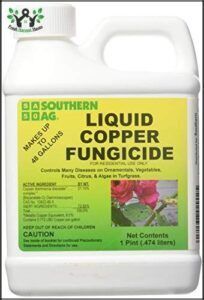
When you’ve got resistant cultivars in place, liquid copper fungicide becomes your reliable backup weapon. Copper-based fungicides deliver proven results against black spot, powdery mildew, and rust when applied correctly.
Start your spraying schedule early in spring before symptoms show up. You’ll want to cover both leaf surfaces thoroughly during dry weather conditions. Application techniques matter—aim for every 14 days during peak disease season for best fungal diseases control.
Here’s your copper spray uses checklist:
- Mix according to label directions and apply when temperatures stay below 85°F
- Rotate with other fungicide options for roses to prevent resistance buildup
- Wear gloves and eye protection as basic safety precautions
Remember the environmental impact—copper accumulates in soil over time, so use it strategically rather than as your only rose disease control method.
2. Disease Control for Roses and Flowers
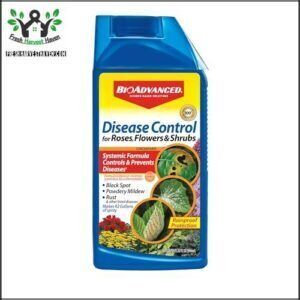
When it comes to keeping roses healthy, you’ll want more than just copper sprays in your arsenal. Mixing things up—like adding beneficial bugs and changing how you care for your plants—works best.
Spotting problems early keeps diseases from spreading, and using systemic fungicides can help protect your roses from the inside out when tough infections show up.
| Fungicide Type | Best For | Application Method |
|---|---|---|
| Systemic fungicides | Internal protection | Soil drench/foliar spray |
| Copper-based fungicides | Preventive treatment | Weekly foliar application |
| Biological controls | Eco-friendly approach | Natural predator release |
| Contact fungicides | Surface protection | Direct leaf coating |
| Combination products | Multi-disease control | Rotating applications |
Rose Care Best Practices
You’ll want to focus on four essential care practices that can make or break your rose garden’s health.
These proven techniques work together to create an environment where fungal diseases struggle to take hold, keeping your roses blooming beautifully all season long.
Watering The Base of The Plant
Smart watering starts at ground level. Target your hose or watering can directly at the soil around your rose’s base, keeping water off the leaves entirely. This Root Zone Hydration approach delivers moisture where it’s needed most while practicing Foliage Moisture Avoidance. Wet foliage creates the perfect breeding ground for fungal diseases like black spot and powdery mildew.
Efficient Water Delivery means soaking the soil slowly and deeply rather than quick surface sprays. This Targeted Irrigation Methods approach prevents Soil Saturation Prevention issues while ensuring thorough root hydration. Your watering techniques become a powerful tool for disease prevention when you remember this simple rule: roses drink through their roots, not their leaves.
Ensuring Good Air Circulation
Proper air circulation dramatically reduces fungal diseases in your rose garden. Spacing roses 2-3 feet apart creates essential airflow benefits for disease prevention.
Use strategic pruning techniques to open crowded centers, removing inner branches that block circulation techniques. These pruning methods let roses breathe freely, making it tough for pathogens to establish.
Good airflow acts like nature’s defense system against infection.
Mulching and Plant Health
Beyond good airflow, mulching creates a foundation for plant health. Apply 2-3 inches of organic material around your roses, keeping it several inches from stems.
This mulch benefits system provides moisture retention, weed control, and furthers nutrient cycling as it decomposes. Soil health improves dramatically, creating an environment where fungal diseases struggle to establish.
Smart cultural practices like proper mulching give your roses the advantage they need for vigorous disease prevention.
Removing Dead Tissue
Your rose garden’s health depends on aggressive removal of dead tissue. Dead leaves, spent blooms, and diseased wood harbor fungal spores that’ll quickly spread to healthy plants. Effective sanitation practices and proper pruning techniques form your first line of defense against fungal diseases.
Here’s your essential disease prevention checklist:
- Disinfect pruning tools with 70% rubbing alcohol between each plant to prevent spreading infections
- Make clean cuts at 45-degree angles above healthy growth nodes, removing all brown or blackened tissue
- Apply wound protection using pruning sealant on cuts larger than half an inch in diameter
Tool sterilization isn’t optional—it’s critical for preventing spread throughout your garden. Remove dead tissue immediately when you spot it, as fungal diseases multiply rapidly in decaying plant matter. Proper disposal means bagging all debris; never compost diseased material.
This systematic approach to encouraging growth while eliminating disease sources keeps your roses thriving season after season.
Preventing Fungal Diseases
You can prevent most fungal diseases in roses by creating conditions that fungi hate, such as good air circulation, proper spacing, and avoiding wet foliage.
Simple practices like watering at the base, removing infected leaves promptly, and choosing disease-resistant varieties will keep your roses healthy and blooming beautifully.
Minimizing Blackspot Development
Understanding the blackspot lifecycle helps you stay one step ahead. This fungal disease spreads through spore dispersal, especially during wet conditions. Weekly inspections catch early signs before damage spreads throughout your garden.
| Prevention Strategy | Timing | Effectiveness |
|---|---|---|
| Leaf sanitation | Weekly | 80% reduction |
| Resistant varieties | Planting | 60% fewer infections |
| Preventative sprays | 7-14 days | 75% disease control |
Remove infected leaves immediately—you’ll stop spore dispersal before it reaches healthy foliage. Choose resistant varieties that naturally fight Black Spot and other fungal diseases. Apply fungicide during morning hours when conditions favor disease prevention. These targeted rose care practices maintain excellent fungal disease control through consistent monitoring and treatment.
Reducing Infection Risk
When reducing infection risk, you’re building a fortress against fungal invaders. Early Detection through weekly inspections catches trouble before it spreads like wildfire through your garden. Tool Sanitization between plants prevents cross-contamination that can devastate your entire rose collection.
Here are three essential Disease prevention strategies that work:
- Maintain proper Soil Health through pH testing and organic amendments
- Practice Spore Reduction by removing fallen leaves and debris immediately
- Choose varieties with Host Resistance to minimize vulnerability
Working these habits into your routine helps keep fungal diseases from taking hold in the first place.
Supporting Plant Health
Strong nutrient balance creates the foundation for healthy roses that naturally resist fungal diseases. Feed your plants with balanced fertilizer monthly during the growing season, promoting proper soil health through annual compost additions.
Your water management techniques matter—water at the base to keep leaves dry while maintaining consistent moisture. Beneficial microbes in healthy soil foster root development and stress reduction. Early detection of pest problems prevents weakness that invites disease.
Cultural Practices Growing Environment
Maintaining a Healthy Garden Environment
Creating the right growing environment acts like building a defensive shield around your roses. Your garden’s overall health determines whether fungal diseases thrive or struggle to survive.
Start with soil health – well-draining, nutrient-rich earth creates the foundation for strong immunity. Garden hygiene matters too: sanitize tools between cuts and remove debris that harbors spores. Smart companion planting with non-host species reduces disease spread by up to 50%.
Focus on these cultural practices that work together:
- Full sun locations with at least six hours of direct sunlight
- Air circulation through proper spacing (2-3 feet between plants)
- Water management at soil level, avoiding wet foliage
- Pest control to reduce plant stress and vulnerability
Morning watering gives leaves time to dry completely before evening. This growing environment approach prevents problems naturally rather than treating them after they start.
Frequently Asked Questions (FAQs)
How to prevent fungus on roses?
Think of your roses as knights needing armor against invisible enemies.
You’ll prevent fungus by maintaining proper spacing for airflow, watering at soil level, removing infected leaves promptly, and applying preventative fungicides regularly.
What is a preventative fungicide for roses?
You’ll want fungicides containing myclobutanil or tebuconazole for roses. Apply these preventatively every 7-14 days during growing season. Neem oil works as a natural alternative for mild infections.
How to keep roses from getting disease?
You’ll prevent rose diseases by spacing plants for airflow, removing infected leaves immediately, using clean pruning tools, applying preventative fungicides, and choosing disease-resistant varieties for your garden.
What is a natural fungicide for rose bushes?
Nearly 60% of new rose varieties show resistance, but if you want a quick fix, try a milk and water spray or neem oil—both natural fungicides that tackle mild fungal issues without breaking the bank.
How to make rose disease resistant?
Choose rose varieties bred for disease resistance and give each plant plenty of breathing room—think social distancing for flowers.
Water at the base, mulch well, and sanitize pruning tools. Healthy soil and sharp eyes make all the difference.
When should I apply dormant spray?
Apply dormant spray in late winter or early spring, before your roses bud or leaf out. You’ll knock out hidden pests and fungal spores, almost like hitting the reset button on your garden.
How often can I reapply fungicides?
Think of fungicides like your umbrella on a rainy day—reapply every 7–14 days, especially after heavy rain.
Always follow label directions for your specific product to avoid overdoing it and harming your roses.
Are organic treatments effective against fungi?
You’ll get some mileage from organic treatments like neem oil, baking soda, or a milk spray, especially for mild outbreaks.
Still, they aren’t silver bullets—persistent fungi may dodge them, so quick follow-up’s key.
Can companion planting reduce fungal diseases?
Diversified planting slashes black spot spore spread by 30–50%. Mixing roses with non-host companions, like herbs, lets you outsmart fungi.
It’s like giving the neighborhood bully fewer playgrounds. Your garden stays safer, longer.
Should I remove surrounding mulch when infected?
No need to toss all your mulch—just remove mulch directly beneath and around infected plants.
Fungal spores often hitch a ride in debris, so swapping out the top two inches gives your roses a fresh start.
Conclusion
Think of your garden as a fortress against fungal invaders—proper planning is your best armor. By focusing on preventing fungal diseases in roses through smart choices, regular pruning, and good hygiene, you’ll keep your plants thriving and blooms vibrant.
Don’t forget, full sun and airflow are your secret weapons. Stay alert, tidy up debris, and use copper sprays when needed. Your roses deserve every advantage, and so do you in your fight for a healthy, blooming garden.
- https://extension.okstate.edu/fact-sheets/diseases-of-roses.html
- https://www.albuquerquerose.com/wp-content/uploads/2024/08/A-Guide-to-Rose-Diseases-and-their-Management.pdf
- https://rose.org/fungicides-made-simple/
- https://www.frontiersin.org/journals/microbiology/articles/10.3389/fmicb.2023.1199024/full
- https://hgic.clemson.edu/factsheet/rose-diseases/

